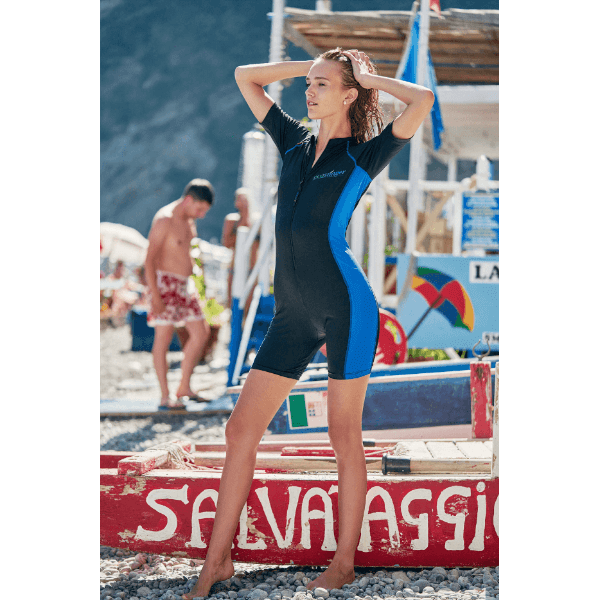Women Men Girls and Boys Full Body UV Swimsuits
Protect against UVA UVB, Jellyfish Stingers, Sea Lice and Sandflies
Stay safe and comfortable in EcoStinger® full body swimsuits, also called stinger suits, dive skins, or sunsuits. Made from UPF50+ UV-protective, chlorine-resistant fabric, these suits block over 97.5% of UVA and UVB rays, protect against jellyfish stingers, sea lice and sandflies, keeping your skin cool and dry.
Designed for men, women, and kids, EcoStinger® swimsuits offer a perfect body fit with excellent stretch and recovery, retain color and shape, and dry quickly. Ideal for all water and beach sports, including: Swimming, snorkeling, diving, surfing, sailing, water skiing, and paddle sports; also competitive swimming and open-water events.
Wear alone or under wetsuits for easier donning. Suitable for warm, cool, or cold water, as well as heated and chlorinated pools, perfect for year-round use.

Keep Your Skin Protected & Healthy all Day Long at the Beach or Pool!
EcoStinger® Stinger Suits and Sunsuits are expertly designed to provide superior protection against the sun’s harmful UV rays, while also guarding your skin from jellyfish stings and mosquito bites. Each suit offers full-body coverage to help prevent abrasions from sand, rocks, and other rough surfaces—keeping you safe and comfortable in both beach and pool environments.
What Is The Difference Between Regular And Sun Protection Swimwear UPF50+?
1. Fabric Type: Regular and sun-protection swimwear are typically made from specialized stretch fabrics designed for use in water. These fabrics are commonly composed of Nylon, Lycra, Elastane, Spandex, or Polyester yarns. The quality and performance of the garment depend on both the fabric composition—such as Nylon/Lycra or Polyester/PBT blends—and the fabric weight, which usually ranges from 170 to 200 grams per square meter (5 to 5.9 oz per square yard).
To achieve UV protection, the fabric must be tightly knitted to effectively block the sun’s ultraviolet rays from penetrating and reaching the skin. As a result, some regular swimwear fabrics may not provide adequate sun protection. The highest possible UV protection rating a fabric can achieve is UPF50+, which blocks more than 97.5% of the sun’s UV radiation according to Australian Radiation Protection and Nuclear Safety Agency (ARPANSA).
UPF50 means that only 1/50th (or 2%) of UV radiation can penetrate the fabric. In other words, the fabric blocks 98% of the sun’s UV rays, that is the maximum any fabric can be certified for, therefore claiming 100% sun protection for clothing, swimwear or sun hats is an incorrect statement.
2. Design Style: The design differences between regular and sun-protection swimwear are quite distinct. Regular swimwear often follows fashion trends and personal style preferences, typically exposing more skin for aesthetic appeal. In contrast, sun-protection swimwear is purposefully designed to cover as much skin as possible, providing effective defense against harmful UV radiation.
Garments such as stinger suits, dive skins, and full-body swimsuits are specifically engineered to cover the arms and legs, ensuring all-day protection from the sun’s harsh rays. This coverage helps prevent sunburn, skin damage, and in severe cases, skin cancer, allowing wearers to enjoy the water safely and confidently.
3. Body Fit: UV-protection swimsuits are designed with a snug, body-hugging fit that enhances performance and ensures optimal UV coverage. Because this fit is similar to slim-fit sizing, it is generally recommended to choose one size larger than your regular swimwear or clothing size for maximum comfort.
Over exposure to the sun UV rays can damage the skin!
Millions of people head outdoors every year when the weather warms up, in fact the historical statistical records by census.gov put the number of Amrerican adults participation in beach leisure activities at around 60 million people not including children (Census Bureau of USA). In 2021, the latest year for which incidence data are available, 90,365 new cases of Melanomas of the skin were reported in the United States (Centers for Disease Control and Prevention).
Over exposure to the sun rays can severely damage the skin cells and may ultimately lead to skin cancer! Protecting yourself and your family from an early age can help preserve your skin natural elements. Although sunscreen is a great tool to help prevent sun damage, but it is not enough on its own. When spending any amount of time in the sun, it is essential to wear uv protective garments and sun hats in addition to applying sunscreen on exposed skin such as face hands and feet to minimize the effects of the sun's ultraviolet rays.








